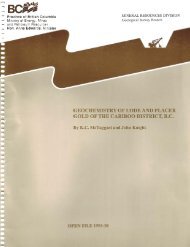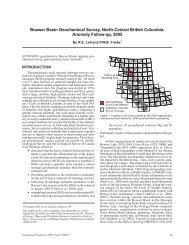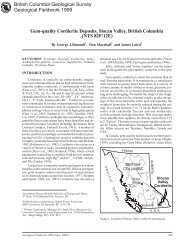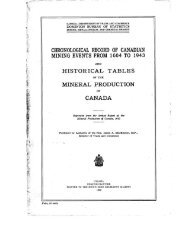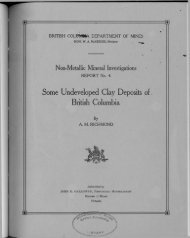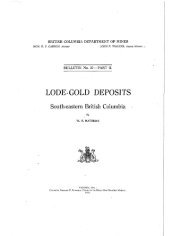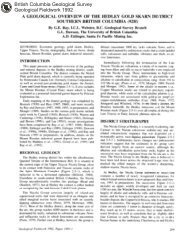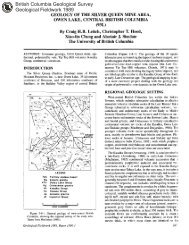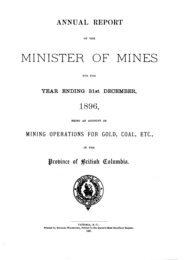Heavy Mineral Sampling of Stream Sediments for Diamond and ...
Heavy Mineral Sampling of Stream Sediments for Diamond and ...
Heavy Mineral Sampling of Stream Sediments for Diamond and ...
Create successful ePaper yourself
Turn your PDF publications into a flip-book with our unique Google optimized e-Paper software.
<strong>Heavy</strong> <strong>Mineral</strong> <strong>Sampling</strong> <strong>of</strong> <strong>Stream</strong> <strong>Sediments</strong> <strong>for</strong><br />
<strong>Diamond</strong> <strong>and</strong> Other Indicator <strong>Mineral</strong>s<br />
in the Atlin-Nakina Area (NTS 104N <strong>and</strong> 104K)<br />
by D. Canil 1 , M. Mihalynuk 2 , J.M. MacKenzie 1 , S.T. Johnston 1 , L. Ferreira 1 <strong>and</strong> B. Grant 2<br />
KEYWORDS: Atlin, diamond, heavy mineral indicator,<br />
kimberlite, eclogite, placer, ophiolite, Cache Creek,<br />
subduction, mantle tectonite.<br />
INTRODUCTION<br />
Kimberlite <strong>and</strong> lamproite magmas sample diamonds<br />
deep in the mantle <strong>and</strong> depending on the rapidity <strong>of</strong> ascent<br />
<strong>and</strong> emplacement, bring them to the surface in various<br />
states <strong>of</strong> preservation. Economic diamond deposits are usually<br />
hosted in primary kimberlite <strong>and</strong> lamproite diatremes<br />
that intrude Archean crustal provinces. Placer deposits <strong>of</strong><br />
diamonds that are sourced in kimberlite from Archean<br />
crustal provinces are also well known.<br />
<strong>Diamond</strong> occurrences have also been documented in<br />
more non-traditional settings. For example, some placer diamonds<br />
appear to have a source in orogenic belts that border<br />
Precambrian crustal provinces (van Roermund et al,<br />
2002; Griffin et al, 2000; Barrows et al, 1996; Walker<br />
1994). Increasing recognition <strong>of</strong> diamonds in metapelitic<br />
metamorphic rocks in recent years has clearly demonstrated<br />
the burial <strong>of</strong> rocks to hundreds <strong>of</strong> kilometres depth<br />
during collisional orogenesis. Although reported decades<br />
earlier in ophiolite <strong>and</strong> ‘Alpine” ultramafic rocks in<br />
orogenic settings, such occurrences <strong>of</strong> diamond have met<br />
with greater skepticism <strong>and</strong> controversy. This is due to the<br />
lack <strong>of</strong> evidence <strong>for</strong> the high pressures required to stabilize<br />
diamond in the mineral assemblages typical <strong>of</strong> ophiolites,<br />
<strong>for</strong> which far lower temperature (T) <strong>and</strong> pressure (P) conditions<br />
are commonly envisioned <strong>for</strong> origin, exhumation <strong>and</strong><br />
emplacement.<br />
There are several reports <strong>and</strong> rumours <strong>of</strong> ‘anomalous’<br />
alluvial diamonds in streams <strong>and</strong> gravels from southeastern<br />
Alaska, southwestern Yukon <strong>and</strong> northwestern British Columbia<br />
(Black, 1951, 1953; Casselman & Harris 2002).<br />
The source <strong>of</strong> such diamonds is not obvious. There are no<br />
known Archean crustal provinces in these regions <strong>and</strong> no<br />
evidence <strong>of</strong> diamond-bearing alkaline igneous rocks,<br />
which could have been eroded to produce detrital diamond.<br />
Alluvial transport is unlikely because drainage patterns in<br />
the region are not obviously sourced in any Precambrian<br />
1 School <strong>of</strong> Earth <strong>and</strong> Ocean Sciences, University <strong>of</strong> Victoria,<br />
Victoria, B.C., V8W 3P6<br />
2 Geoscience, Research <strong>and</strong> Development Branch, Ministry <strong>of</strong><br />
Energy <strong>and</strong> Mines, Victoria, BC<br />
19<br />
crustal province to the east. Glacial transport is unlikely because<br />
some regions in southwestern Yukon north <strong>of</strong> the<br />
Denali fault are reported to contain alluvial diamonds, yet<br />
they have not been glaciated.<br />
The recognition <strong>of</strong> microdiamond in harzburgite<br />
tectonite from ophiolite elsewhere (van Roermund et al,<br />
2002) begs the question whether diamond occurrences in<br />
southeastern Alaska, southwestern Yukon <strong>and</strong> northwestern<br />
British Columbia are sourced in ophiolites or in high<br />
pressure-low temperature metamorphic rocks (blueschists<br />
<strong>and</strong> eclogites) in accretionary margins associated with<br />
ophiolites. Large mantle tectonite sections <strong>of</strong> ophiolite<br />
have been recognized <strong>and</strong> documented in greater detail in<br />
these regions, <strong>and</strong> blueschist <strong>and</strong> eclogite occur in several<br />
parts <strong>of</strong> Yukon, <strong>and</strong> in the Cache Creek Terrane <strong>of</strong> British<br />
Columbia. To address this question, <strong>and</strong> ultimately to explain<br />
the source <strong>of</strong> anomalous diamond occurrences in the<br />
northern Cordillera, we carried out a comprehensive study<br />
<strong>of</strong> heavy minerals in sediments sampled from streams,<br />
which drain ophiolite bedrock in the Atlin-Nakina area <strong>of</strong><br />
northwestern British Columbia. The Atlin area is known<br />
historically <strong>for</strong> its placer gold mining operations, where<br />
one such anomalous diamond occurrence has been reported<br />
in Wilson Creek (Casselman <strong>and</strong> Harris, 2002). We wished<br />
to test if other diamonds could be found, by investigating<br />
stream sediments <strong>for</strong> diamonds or minerals, which may be<br />
indicative <strong>of</strong> bedrock that is associated with a high<br />
pressures origin <strong>and</strong> thus could be linked with the<br />
occurrence <strong>of</strong> diamond.<br />
METHODS<br />
Fifteen stream locations were sampled in map areas<br />
NTS 104N <strong>and</strong> 104K. <strong>Stream</strong>s were chosen that drain bedrock<br />
<strong>of</strong> mantle tectonite in ophiolite. Two samples were<br />
also collected from commercial placer operations on Wilson<br />
<strong>and</strong> Feather creeks, from the tailings <strong>of</strong> clean-up<br />
sluices. Control samples were also collected from below<br />
the placer workings in these two creeks. A sample was collected<br />
from McKee Creek, <strong>of</strong>f the sluice box end during active<br />
mining within a pay streak.<br />
<strong>Stream</strong> sediment samples were taken in stream flow<br />
gradients that would efficiently concentrate heavy minerals<br />
in the bedload. <strong>Stream</strong> sediments were sieved on site to<br />
grain sizes less than 2 mm. The resultant sieved samples<br />
(4 to 8 kg) were processed <strong>for</strong> heavy minerals at Vancouver
35<br />
30<br />
25<br />
20<br />
15<br />
10<br />
5<br />
Perido Pk<br />
Scarface<br />
Wilson Ck<br />
Nahlin<br />
Sloko<br />
Nimbus<br />
Feather<br />
Atlin (104N) <strong>and</strong><br />
adjacent areas<br />
(region shaded on inset)<br />
Sloko River<br />
Goldbottom<br />
Creek<br />
Atlin 104N<br />
Tulsequah 104K Nahlin<br />
} Plutons cutting - mid Jurassic<br />
McKee<br />
Creek<br />
Wilson<br />
Creek<br />
Eclogite<br />
conglomerate<br />
ultramafic rocks - Late Cretaceous<br />
gabbro<br />
mantle tectonite <strong>and</strong> serpentinite<br />
melange<br />
Olivine<br />
Feather<br />
Creek<br />
0<br />
0.55 0.6 0.65 0.7 0.75 0.8 0.85 0.9 0.95<br />
Mg/(Mg+Fe)<br />
Fig. 2 – Histogram showing olivine compositions in heavy mineral<br />
samples at each locality.<br />
<br />
134 0<br />
Whitehorse<br />
60 60 N<br />
00<br />
Tagish<br />
Lake<br />
Atlin<br />
Lake<br />
“Scarface”<br />
melange<br />
Mt. Nimbus<br />
Jos’alun<br />
west <strong>and</strong> east<br />
Peridotite Peak<br />
west <strong>and</strong> east<br />
Teslin Fault<br />
Yukon<br />
BC<br />
bulk heavy stream sediment sample<br />
heavy collected from sluice box<br />
heavy collected from finishing sluice end runs<br />
heavy minerals concentrated from rock sample<br />
Placer claims<br />
4<br />
2<br />
Teslin<br />
Lake<br />
132 0<br />
Nahlin Fault<br />
Perido Pk<br />
Nahlin<br />
Sloko<br />
Thibert Fault<br />
King Salmon Thrust<br />
Nimbus<br />
Feather<br />
Takla<br />
Lake Lake<br />
Dease<br />
Lake<br />
Mountain<br />
Dease<br />
Lake ST<br />
ST ST<br />
Kutcho<br />
Creek<br />
Ashcr<strong>of</strong>t<br />
TERRANES<br />
Orthopyroxene<br />
0<br />
0.61 0.68 0.75 0.82 0.89<br />
Mg/(Mg+Fe)<br />
Fig. 3 - Histogram showing orthopyroxene compositions in heavy<br />
mineral samples at each locality.<br />
ST<br />
QN<br />
Cache<br />
Creek<br />
Stikine<br />
Quesnel<br />
20<br />
0 40 km<br />
Fig. 1 - Bedrock geology highlighting ultrmafic rocks <strong>of</strong> the Atlin-Nakina area (after Mihalynuk et al 2003) <strong>and</strong> showing location <strong>of</strong> heavy<br />
mineral samples used in this study.<br />
20<br />
ATLIN<br />
Nakina<br />
58 N<br />
0
Indicator Processors Inc. Samples were wet screened to<br />
less than 0.25 mm fraction, passed through a magnetic separator<br />
operating at 2.1 Tesla, <strong>and</strong> underwent two steps <strong>of</strong><br />
heavy liquid separation to specific gravities greater than<br />
3.33.<br />
The non-magnetic heavy mineral fractions were<br />
picked <strong>for</strong> diamond <strong>and</strong> gold by I & M Morrison Geological<br />
Services. Magnetic heavy mineral fractions were<br />
h<strong>and</strong>-picked at the University <strong>of</strong> Victoria. In each sample,<br />
20-30 grains <strong>of</strong> each mineral were picked, mounted in epoxy,<br />
<strong>and</strong> polished. Major element compositions <strong>of</strong> the<br />
grains in eight <strong>of</strong> the fifteen samples were determined by<br />
electron microprobe analysis at the University <strong>of</strong> British<br />
Columbia. Operating procedures <strong>and</strong> data reduction methods<br />
<strong>for</strong> this instrument are similar to those described in<br />
MacKenzie <strong>and</strong> Canil, 1999.<br />
RESULTS<br />
NON-MAGNETIC FRACTION<br />
No diamonds were found in any <strong>of</strong> the non-magnetic<br />
heavy mineral fractions. Gold grains up to 1 mm in size<br />
were recognized in sediments from north <strong>of</strong> Hard Luck<br />
Peaks, Mt. Nimbus <strong>and</strong> in Feather Creek. Lack <strong>of</strong> gold in<br />
the McKee Creek sample may be an indication <strong>of</strong> an efficient<br />
placer operation.<br />
MAGNETIC FRACTION<br />
Table 1 lists the major minerals identified in the magnetic<br />
heavy mineral fraction from each sample studied. The<br />
subdivision into different groups <strong>of</strong> the same mineral was<br />
based in part on optical examination, but mainly on mineral<br />
chemical observations that are described in more detail<br />
below.<br />
X CaTs<br />
0.16<br />
0.14<br />
0.12<br />
0.1<br />
0.08<br />
0.06<br />
0.04<br />
0.02<br />
0<br />
0.4 0.5 0.6 0.7 0.8 0.9 1<br />
Mg/(Mg+Fe)<br />
Fig. 4. Plot <strong>of</strong> Mg# in clinopyoxene in heavy mineral samples<br />
versus its Al-content expressed as the mole fraction <strong>of</strong> its<br />
CaTschermaks (CaTs) component (CaAl2SiO6). Clinopyroxenes<br />
from mantle tectonites plot right <strong>of</strong> the vertical line at Mg# = 0.9.<br />
OLIVINE<br />
Perido Pk<br />
Scarface<br />
Goldbottom<br />
Wilson<br />
Nahlin<br />
Sloko<br />
Nimbus<br />
Feather<br />
Laberge clasts<br />
Clinopyroxene<br />
Olivine was identified optically in heavy fractions by<br />
its light green colour <strong>and</strong> conchoidal fracture. In some<br />
cases, olivine preserved exceptionally well-defined crystal<br />
habit <strong>and</strong> faceted faces, indicative <strong>of</strong> an igneous origin, <strong>and</strong><br />
little abrasion during transport from proximal source rock.<br />
Olivine from mantle tectonite in ophiolite has a distinctly<br />
high Mg/(Mg+Fe) (Mg# > 0.89) <strong>and</strong> lower CaO<br />
content when compared to olivine from cumulate plutonic<br />
rocks, or from phenocrysts in volcanic rocks. This is due to<br />
the distinctly higher Mg# <strong>and</strong> lower Ca content <strong>of</strong> the bulk<br />
TABLE 1. SUMMARY OF MINERALS IN THE ATLIN-NAKINA HEAVY MINERAL CONCENTRATE SAMPLES<br />
Gold Olivine Clinopyroxene Garnet Cr-Spinel Spinel<br />
Sample # Location Grains Mantle Cumulate Mantle Cumulate Eclogitic Eclogitic Skarn Mantle Cumulate<br />
15-4 BB Scarface * * * * * * * * *<br />
24-4b* Feather Ck. sluice end run *<br />
24-1 Feather Ck. * * * * *<br />
16-4 BW Goldbottom Ck. * * *<br />
16-3 BW Hardluck Peaks North *<br />
7-1 WB Hard Luck Peaks East<br />
16-2* Laberge Gp. coarse wacke * *<br />
18-1 WW McKee Ck Sluice box run-<strong>of</strong>f<br />
18-7 BW Mt. Nimbus North * * * * *<br />
18-4 BW Nahlin Mtn. North * * * * * *<br />
11-14 BB Peridotite Peak North * * * * * *<br />
18-5 BW Peridotite Peak East<br />
18-6 BW Sloko River * * * * * * *<br />
18-3 WW Wilson Ck. * * * * *<br />
18-2 WW Wilson Ck. sluice end run<br />
samples in bold face analysed by EMP<br />
21
X CaTs<br />
0.2<br />
0.15<br />
0.1<br />
0.05<br />
granulite<br />
compositions <strong>of</strong> mantle tectonites, which represent lithosphere<br />
<strong>for</strong>med as a residue <strong>of</strong> basalt extraction. Olivine<br />
with Mg# greater than 0.89 <strong>and</strong> low in CaO content ( 0.5 wt%) <strong>and</strong> poor in Na, which is<br />
an incompatible element during melting.<br />
22<br />
A<br />
B
Clinopyroxene with Mg# greater than 0.9, <strong>and</strong> rich in<br />
Al as a Ca-Tschermaks (CaTs - CaAl2SiO6) component is<br />
represented only at Nahlin, Scarface <strong>and</strong> Peridotite Peak<br />
(Fig. 4). Clinopyroxenes with lower Mg# <strong>and</strong> Cr contents at<br />
other sample locations must have been eroded from other<br />
sources. Many <strong>of</strong> these grains have high CaTs <strong>and</strong> so could<br />
be derived from cumulate rocks (Fig. 5) but a few <strong>of</strong> these<br />
clinopyroxenes in the Scarface <strong>and</strong> Sloko samples are distinctly<br />
rich in jadeite (Jd - NaAlSi2O6) component indicative<br />
<strong>of</strong> an eclogitic paragenesis. Clinopyroxenes from the<br />
latter locations are almost certainly derived from eclogite<br />
source rock, because clasts <strong>of</strong> this rock type with identical<br />
Jd-rich clinopyroxene compositions are recognized in a<br />
distinct ridge <strong>of</strong> garnetiferous wacke within the Laberge<br />
group to the west. This source rock is also supported in the<br />
chemistry <strong>of</strong> garnets described below.<br />
GARNET<br />
Garnets were recognized by their pink, purplish pink<br />
or orange colour, <strong>and</strong> in some cases well-developed<br />
dodecahedral crystal faces. The dominant garnet in all samples<br />
is a pink variety, poor in pyrope (XPyr 0.89) <strong>and</strong> that typical <strong>of</strong> cumulate rocks<br />
from ophiolites <strong>and</strong> layered intrusions (Mg# 0.80). Also<br />
shown <strong>for</strong> comparison is the range <strong>of</strong> spinel compositions<br />
in <strong>for</strong>ty grains from two harzburgite samples from mantle<br />
tectonite in outcrop north <strong>of</strong> Hard Luck Peaks. Application<br />
<strong>of</strong> Fe-Mg exchange thermometry applied to coexisting olivine<br />
<strong>and</strong> spinel in these two samples show they last<br />
equilibrated between 700 <strong>and</strong> 850ºC.<br />
Almost all locations contain some proportion <strong>of</strong><br />
Cr-spinel that could have been in equilibrium with mantle<br />
olivine (Mg# ~ 0.9) at temperatures measured using olivine-spinel<br />
geothermometry <strong>for</strong> the harzburgite samples<br />
(Fig. 7). The majority <strong>of</strong> the spinel grains at each location,<br />
however, occur along an array that is indicative <strong>of</strong> equilibrium<br />
with olivine that has a far lower Mg# than typical mantle<br />
olivine. The majority <strong>of</strong> these spinels are apparently de-<br />
80
ived from rocks in equilibrium with olivine having a Mg#<br />
between 0.9 <strong>and</strong> 0.8, likely in cumulate rocks. The latter interpretation<br />
is borne out by the abundance <strong>of</strong> olivine compositions<br />
having Mg# between 0.86 <strong>and</strong> 0.75 in most samples<br />
(Fig. 2), as well as the euhedral nature <strong>of</strong> many spinel<br />
grains, which is expected <strong>for</strong> magmatic spinel in plutonic<br />
ultramafic rocks, but not <strong>for</strong> spinel recrystallized at high<br />
temperature in mantle tectonites.<br />
TITANITE<br />
Titanites were recognized as equant red-brown grains.<br />
All <strong>of</strong> the titanites are low in Al2O3 (< 2 wt%) indicative <strong>of</strong><br />
protoliths from low P environments likely as accessory<br />
phases in felsic plutonic rocks.<br />
DISCUSSION AND CONCLUSIONS<br />
The Mg-rich compositions <strong>of</strong> olivine, clinopyroxene<br />
<strong>and</strong> spinel in samples from Peridotite Peak, Scarface <strong>and</strong><br />
Sloko suggest a mantle tectonite source <strong>for</strong> heavy minerals<br />
in the samples. Several large masses <strong>of</strong> mantle tectonite<br />
crop out throughout the study area, <strong>and</strong> sample sites were<br />
chosen in the drainages <strong>of</strong> these regions to examine them as<br />
potential sources <strong>for</strong> diamond (Fig. 1). Ironically, there are<br />
many sample sites containing large proportions <strong>of</strong> olivine<br />
<strong>and</strong> spinel that are not sourced in mantle tectonite. Indeed,<br />
somewhat perplexing is the preponderance <strong>of</strong> olivine,<br />
clinopyroxene, spinel <strong>and</strong> orthopyroxene having mineral<br />
compositions with lower Mg# more indicative <strong>of</strong> cumulate<br />
rocks from the crustal section <strong>of</strong> ophiolites. Although<br />
peridotite cumulates are known from the lower crustal section<br />
<strong>of</strong> some ophiolites, they are not as well represented<br />
proportionately in outcrops <strong>of</strong> the Atlin-Nakina area. Only<br />
a small section less than 100 m thick <strong>of</strong> peridotite cumulate<br />
is recognized just north <strong>of</strong> Hard Luck Peaks. Gabbro in the<br />
same lower crustal section is very poor in olivine (< 5%).<br />
Larger tracts <strong>of</strong> 104 N/1 are underlain by gabbro, but these<br />
are not obviously rich in olivine. Thus, the source <strong>for</strong> cumulate<br />
olivine, spinel <strong>and</strong> clinopyroxene in the heavy minerals<br />
from most <strong>of</strong> the samples remains puzzling. One possibility<br />
is that a large proportion <strong>of</strong> the serpentinite melange<br />
throughout the Atlin-Nakina is an alteration product <strong>of</strong> cumulate<br />
peridotite, rather than mantle tectonite. The<br />
melange units, being less competent <strong>and</strong> easily eroded,<br />
could contribute more to stream sediments. If so, it remains<br />
unclear how fresh igneous olivine <strong>and</strong> spinel grains would<br />
have been preserved in melange that is heavily altered to<br />
serpentine <strong>and</strong> magnetite.<br />
The presence <strong>of</strong> eclogitic garnet <strong>and</strong> clinopyroxene in<br />
several heavy mineral samples is also significant. Exposures<br />
<strong>of</strong> this rock type are sporadic in the Cordillera, but<br />
known at one locality on the eastern margin <strong>of</strong> Cache Creek<br />
Terrane in British Columbia <strong>and</strong> further north in Yukon<br />
Tanana Terrane <strong>of</strong> Yukon. The results <strong>of</strong> this study are intriguing<br />
in that they show widespread occurrence <strong>of</strong> this<br />
rock as a source <strong>for</strong> the heavy minerals from at least five locations,<br />
some as far east as Peridotite Peak, yet no eclogite<br />
has been recognized in outcrop in the Atlin-Nakina area.<br />
Clasts <strong>of</strong> eclogite have only been recently documented (in<br />
the past field season) in a coarse garnetiferous wacke <strong>of</strong> the<br />
Laberge Group to the west. These rare clasts are less than 1<br />
cm, but are likely the source <strong>of</strong> much <strong>of</strong> the garnet within<br />
this particular unit <strong>of</strong> the Laberge Group, as evidenced by<br />
the great abundance <strong>of</strong> eclogitic minerals in heavy mineral<br />
concentrate from a stream draining this region.<br />
The Laberge Group coarse wacke is the only known<br />
bedrock containing eclogitic garnets <strong>and</strong> pyroxenes in the<br />
Atlin region, but is an unlikely source <strong>for</strong> these heavy minerals<br />
throughout the entire study area. The Laberge wacke<br />
crops out only in the western portion <strong>of</strong> the study area west<br />
<strong>of</strong> the Nahlin fault. Ice flow during the last glaciation in the<br />
Atlin area was west to east. Glacial transport could explain<br />
the presence <strong>of</strong> eclogitic grains in stream sediments proximal<br />
to the Sloko site, such as at Wilson <strong>and</strong> Feather Creeks.<br />
Outside <strong>and</strong> further south <strong>of</strong> the Atlin area, however, the<br />
orientation <strong>of</strong> mega-rat-tail features on air photos suggests<br />
ice directions were southward, <strong>and</strong> yet eclogitic garnets are<br />
recognized over 100 km to the east near Black Caps Mountain,<br />
<strong>and</strong> Peridotite Peak. These occurrences require a more<br />
proximal source <strong>for</strong> eclogite in outcrop than units <strong>of</strong> the<br />
Laberge Group. Such a source is not obvious, but may lie<br />
within the melange units that are widespread in the<br />
Atlin-Nakina area. Eclogite blocks are common in the classic<br />
Franciscan mélange , <strong>and</strong> may also be present yet unrecognized<br />
in large areas <strong>of</strong> mélange throughout the Nakina<br />
area. As is the case with the source rock <strong>for</strong> cumulate olivine<br />
<strong>and</strong> spinels, the melange units are easily eroded, <strong>and</strong><br />
could contribute their eclogitic material to stream<br />
sediments.<br />
The source <strong>of</strong> eclogite clasts, Mg-rich mantle olivine<br />
<strong>and</strong> Cr-spinel in the garnetiferous wacke unit in the<br />
Laberge Group is likely to be ophiolite <strong>and</strong> associated<br />
melange that was part <strong>of</strong> Cache Creek Terrane to the east.<br />
Erosion <strong>of</strong> uplifted ophiolite <strong>and</strong> eclogite in mélange from<br />
the Cache Creek Terrane would have shed detritus into the<br />
basin accumulating proximal to the structures along which<br />
the ophiolite <strong>and</strong> melange were exhumed. Similar detritus<br />
is present in flysch deposits proximal to many ophiolites,<br />
such as the Bay <strong>of</strong> Isl<strong>and</strong>s, Newfoundl<strong>and</strong> <strong>and</strong> Labrador,<br />
<strong>and</strong> is interpreted to have accumulated after convergence,<br />
uplift <strong>and</strong> collapse. An outst<strong>and</strong>ing problem is that no<br />
eclogite units have been found in outcrop in the mélange.<br />
Further stream sediment sampling <strong>and</strong> processing <strong>of</strong> the remaining<br />
seven samples <strong>of</strong> this study may aid in identifying<br />
its location. Future study <strong>of</strong> the eclogite-bearing conglomerate<br />
should include careful paleocurrent study to test<br />
whether or not simple turbidity currents could have carried<br />
the clasts from the adjacent Cache Creek rocks.<br />
A diamond in the Atlin area was originally reported<br />
over 10 years ago by Marvin Sherman in a placer operation<br />
on Wilson Creek. The yellowish white diamond was ~6 mm<br />
in diameter with a rough rounded shape. None <strong>of</strong> the heavy<br />
mineral samples from this study, including one on Wilson<br />
Creek, produced any diamonds. This study shows that the<br />
Wilson Creek diamond, if real, was not obviously sourced<br />
in mantle tectonite from ophiolite. The Wilson Creek occurrence,<br />
as well as those to the north in Yukon, remains<br />
enigmatic.<br />
24
ACKNOWLEDGMENTS<br />
We sincerely thank Norm Graham <strong>of</strong> Discovery Helicopters<br />
in Atlin <strong>for</strong> getting us to where we wished to go, <strong>and</strong><br />
Ryan Rhodes <strong>for</strong> mineral picking. This study was carried<br />
out under the Atlin Targeted Geoscience Initiative. Olmer<br />
Brown <strong>and</strong> John Harvey provided access to placer workings<br />
at McKee Creek. Dale Halstead provided access to the<br />
Feather Creek placer workings <strong>and</strong> clean-up heavy minerals.<br />
Peter Burjowski provided access to placer workings on<br />
Wilson Creek <strong>and</strong> clean-up heavy minerals, <strong>and</strong> shared<br />
local diamond lore.<br />
REFERENCES<br />
Ash, C. (1994): Origin <strong>and</strong> tectonic setting <strong>of</strong> the ophiolitic ultramafic<br />
<strong>and</strong> related rocks in the Atlin area, British Columbia<br />
(NTS 104N). B.C. Ministry <strong>of</strong> Energy, <strong>and</strong> Mines,. Bulletin<br />
94, 48 p.<br />
Bai, W.-J., Zhou, M.-F. <strong>and</strong> Robinson, P.T. (1993): Possibly diamond-bearing<br />
mantle peridotites <strong>and</strong> podi<strong>for</strong>m chromitites<br />
in the Luobusa <strong>and</strong> Donqiao ophiolites, Tibet. Canadian<br />
Journal <strong>of</strong> Earth Sciences., 30: 1650-1659.<br />
Ballhaus, C., Berry, R.F. <strong>and</strong> Green, D.H. (1991): High pressure<br />
experimental calibration <strong>of</strong> the olivine-orthopyroxene-spinel<br />
oxygen barometer: implications<br />
<strong>for</strong> the oxidation state <strong>of</strong> the upper mantle. Contrib. <strong>Mineral</strong>.<br />
Petrol., 107: 27-40.<br />
Barrows,L.M.,Lishmunwg,R.,Oakes,M,Barron,B.J.<strong>and</strong><br />
Sutherl<strong>and</strong>, F.L. (1996): Subduction model <strong>for</strong> the origin <strong>of</strong><br />
some diamons i the Phanerozoic <strong>of</strong> eastern New South<br />
Wales; Australian Journal <strong>of</strong> Earth Sciences, vol 43, pp<br />
257-267.<br />
Black, J.M. (1951): Atlin placer camp; BC Ministry <strong>of</strong> Energy <strong>and</strong><br />
Mines, Vertical File 2470 C1, page gl 2 <strong>and</strong> page bl 14.<br />
Black, J.M. (1953): Report on the Atlin placer camp; BC Ministry<br />
<strong>of</strong> Energy <strong>and</strong> Mines, Miscellaneous report, 70 pages.<br />
Brey, G., Köhler, T. <strong>and</strong> Nickel, K.G. (1990):<br />
Geothermobarometry in four-phase lherzolites I. Experimental<br />
results from 10 to 60 kb. J Petrol, 31: 1313-1352.<br />
Canil, D. <strong>and</strong> Johnston, S.T. (2002): Harzburgite Peak: A large<br />
mantle tectonite in ophiolite from southwestern Yukon. Yukon<br />
Geology <strong>and</strong> Exploration, 2002-1: 1-10.<br />
Casselman, S. <strong>and</strong> Harris, W. (2002): Yukon diamond rumour map<br />
<strong>and</strong> notes; Yukon Geology.<br />
Cawood, P.A. <strong>and</strong> Suhr, G. (1992): Generation <strong>and</strong> obduction <strong>of</strong><br />
ophiolites: Constraints from the Bay <strong>of</strong> Isl<strong>and</strong>s complex,<br />
western Newfoundl<strong>and</strong>. Tectonics, 11: 884-897.<br />
Coleman, R.G., Lee, D.E., Beatty, L.B. <strong>and</strong> Brannock, W.W.<br />
(1965): Eclogites <strong>and</strong> eclogites: Their simularities <strong>and</strong> differences.<br />
Geological Society <strong>of</strong> America Bulletin 76:<br />
483-508.<br />
Erdmer, P., Ghent, E.D., Archibald, D.A. <strong>and</strong> Stout, M.Z., (1998):<br />
Paleozoic <strong>and</strong> Mesozoic high-pressure metamorphism at the<br />
margin <strong>of</strong> ancestral North America in central Yukon. Geological<br />
Society <strong>of</strong> America Bulletin 110: 615-629.<br />
Foster, H.L., Keith, T.E.C. <strong>and</strong> Menzie, W.D. (1994): Geology <strong>of</strong><br />
the Yukon-Tanana area <strong>of</strong> east-central Alaska. In: G.<br />
Pflacker <strong>and</strong> H.C. Berg (Editors), The Geology <strong>of</strong> North<br />
America. Geological Society <strong>of</strong> America, Boulder, pp.<br />
205-240.<br />
Franz, G. <strong>and</strong> Spear, F.S. (1985): Aluminous titanite (sphene) from<br />
the eclogite zone, south-central Tauern window, Austria.<br />
Chem. Geol., 50: 33-46.<br />
Griffin, W.L., O'Reilly, S.Y <strong>and</strong> Davies, R.M. (2000):<br />
Subduction-related diamond deposits?: Constraints, Possi-<br />
25<br />
bilities <strong>and</strong> new data from Eastern Australia. Reviews in<br />
Economic Geology. Chap 11, pp291-310.<br />
Helmstaedt, H.H. <strong>and</strong> Gurney, J.J. (1994): Geotectonic controls on<br />
the <strong>for</strong>mation <strong>of</strong> diamonds <strong>and</strong> their kimberlitic <strong>and</strong><br />
lamproitic host rocks: Applications to diamond exploration.<br />
Proc. 5th Int. Kimb. Conf., 2: 236-250.<br />
Irvine, T.N. (1965): Chromian spinel as a petrogenetic indicator. I.<br />
Theory. Can. J. Earth Sci., 2: 648-672.<br />
Kaminsky, F.V. <strong>and</strong> Vaganov, V.I. (1977): Petrological conditions<br />
<strong>for</strong> diamond occurrences in Alpine-type ultrabasic rocks.<br />
Inter. Geol. Rev., 19: 1151-1162.<br />
LeCheminant, A.N. <strong>and</strong> Bedard, J.H. (1995): <strong>Diamond</strong>s associated<br />
with ultramafic complexes <strong>and</strong> derived placers. In:<br />
A.N. LeCheminant, D.G. Richardson, R.N.W. DiLabio <strong>and</strong><br />
K.A. Richardson (Editors), Searching <strong>for</strong> <strong>Diamond</strong>s In Canada.<br />
Geol. Surv. Can., Ottawa, pp. 171-177.<br />
LeCheminant, A.N. <strong>and</strong> Kjarsgaard, B.A. (1995) Introduction. In:<br />
A.N. LeCheminant, D.G. Richardson, R.N.W. DiLabio <strong>and</strong><br />
K.A. Richardson (Editors), Searching <strong>for</strong> <strong>Diamond</strong>s In Canada.<br />
Geol. Surv. Can., Ottawa, pp. 5-11.<br />
Levson, V.M. (1992): Quaternary geology o fthe Atlin area<br />
(104N/11W, 12E). in Geological Fieldwork 1991: B.C. Ministry<br />
<strong>of</strong> Energy <strong>and</strong> Mines, p375-385.<br />
Lowe, C. et al. (2003): Overview <strong>of</strong> the Atlin Integrated<br />
Geosceicen Project, northwestern British Columbia, year<br />
three. Geol. Surv. Can. Current Research., 2003-A11: 1-10.<br />
MacKenzie, J.M. <strong>and</strong> Canil, D. (1999): Composition <strong>and</strong> thermal<br />
evolution <strong>of</strong> cratonic mantle beneath the central Archean<br />
Slave Province, NWT, Canada. Contributions to <strong>Mineral</strong>ogy<br />
<strong>and</strong> Petrology, 134: 313-324.<br />
Mercier, J.C. <strong>and</strong> Nicolas, A. (1975): Textures <strong>and</strong> fabrics <strong>of</strong> upper<br />
mantle peridotites as illustrated by xenoliths from basalts. J.<br />
Petrol., 20: 727-741.<br />
Mihalynuk, M.G. et al. (2003): Atlin TGI, Part III: Regional geology<br />
<strong>and</strong> mineralization <strong>of</strong> the Nakina area (NTS 104N/2W<br />
<strong>and</strong> 3). in Geological Fieldwork 2002: B.C. Ministry <strong>of</strong> Energy<br />
<strong>and</strong> Mines, pp 9-15.<br />
Moores, E.M. (1982): Origin <strong>and</strong> emplacement <strong>of</strong> ophiolites. Rev.<br />
Geophys., 20: 735-760.<br />
Moores, E.M. <strong>and</strong> Jackson, E.D. (1974): Ophiolites <strong>and</strong> oceanic<br />
crust. Nature, 228: 837-842.<br />
Proudlock, P.J. <strong>and</strong> Proudlock W.M. (1976): Stratigraphy <strong>of</strong> the<br />
placers in the Atlin placer mining camp, British Columbia;<br />
BC Ministry <strong>of</strong> Energy <strong>and</strong> Mines, Miscellaneous Report, 71<br />
pages.<br />
Roeder, P.L. (1994): Chromite: from the fiery rain <strong>of</strong> chondrules to<br />
the Kilauea Iki lava lake. Can. <strong>Mineral</strong>., 32: 729-746.<br />
Roeder, P.L. <strong>and</strong> Campbell, I.H. (1985): The effect <strong>of</strong> post-cumulus<br />
reactions on composition <strong>of</strong> chrome spinels from the<br />
Jimberlana intrusion. J. Petrol., 26: 763-786.<br />
Shellnutt, J.G., Canil, D. <strong>and</strong> Johnston, S.T. (2001): Preliminary<br />
results <strong>of</strong> a petrological study <strong>of</strong> ultramafic rocks <strong>of</strong> the<br />
northern Cordillera. Yukon Geology <strong>and</strong> Exploration, 2001:<br />
229-237.<br />
Stevens, R.K., (1970): Cambro-Ordovician flysch sedimentation<br />
<strong>and</strong> tectonics in west Newfoundl<strong>and</strong> <strong>and</strong> their possible bearing<br />
on a proto-Atlantic ocean. Geol. Soc. Can. Spec. Pap.,7:<br />
165-177.<br />
van-Roermund, H.L.M, Carswell, D.A., Drury, M.R. <strong>and</strong><br />
Heijboer, T.C. (2002): Microdiamonds in a megacrystic garnet<br />
websterite pod from Bardane on the isl<strong>and</strong> <strong>of</strong> Fjort<strong>of</strong>t,<br />
western Norway; evidence <strong>for</strong> diamond <strong>for</strong>mation in mantle<br />
rocks during deep continental subduction; Geological Society<br />
<strong>of</strong> America,<br />
van Roermund, H.L.M., Carswell, D.A., Drury, M.R. <strong>and</strong><br />
Heijboer, T.C. (2002): Micro-diamonds in a megacrystic<br />
garnet websterite pod from Bardane on the isl<strong>and</strong> <strong>of</strong> Fjort<strong>of</strong>t,
western Norway: evidence <strong>for</strong> diamond <strong>for</strong>mation in mantle<br />
rocks during deep continental subduction. Geology, 30(11),<br />
959-962.<br />
von Seckendorff, V. <strong>and</strong> O’Neill, H.S. (1993): An experimental<br />
study <strong>of</strong> Fe-Mg partitioning between olivine <strong>and</strong><br />
orthopyroxene at 1173, 1273 <strong>and</strong> 1423 K <strong>and</strong> 1.6 GPa.<br />
Contrib <strong>Mineral</strong> Petrol., 113: 196-207.<br />
Walker, R.T. (1994): <strong>Diamond</strong> potential in southeast British Columbia;<br />
Northwest Geology, Proceedings Volume, from<br />
joint meeting <strong>of</strong> British Columbia Geological Survey<br />
Branch, Geological Survey <strong>of</strong> Canada, East Kootenay<br />
Chamber <strong>of</strong> Mines, Consolidated Ramrod <strong>and</strong> Tobacco<br />
Root Geological Society, vol 23, pp 77-79.<br />
White, A.J. (1964): Clinopyroxenes from eclogites <strong>and</strong> basic<br />
granulites. Am. <strong>Mineral</strong>., 49: 883-888.<br />
26





